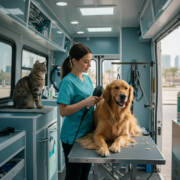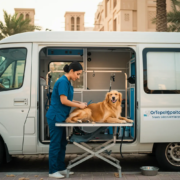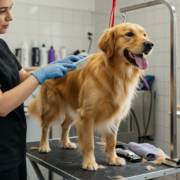How Professional Grooming Helps Reduce Shedding in Dogs and Cats
How Professional Grooming Helps Reduce Shedding in Dogs and Cats
Ah, the joys of pet ownership! The wagging tails, the comforting purrs, the unconditional love… and then there’s the shedding. If you’re a pet parent, you know the struggle all too well: tumbleweeds of fur under the sofa, a fine layer of pet hair on your clothes, and that constant battle with the vacuum cleaner. It’s an inevitable part of having furry companions, but what if I told you there’s a highly effective way to significantly reduce this daily deluge of hair? Indeed, professional grooming isn’t just about making your dog or cat look dapper; it plays a crucial, often underestimated, role in managing and even reducing shedding in dogs and cats. Let’s dive deep into how a skilled groomer can transform your pet’s coat health and bring much-needed relief to your home.
Understanding the Natural Phenomenon of Shedding
Before we explore the solutions, it’s essential to understand the “why” behind shedding. Pets shed for a variety of reasons, most of which are perfectly natural. It’s their body’s way of getting rid of old, damaged, or dead hair, making way for new growth. Factors like breed, season, diet, health, and even stress can influence the amount and frequency of shedding. Dogs and cats, particularly those with double coats, experience seasonal “blowouts” where they shed heavily to adapt to changing temperatures. While shedding is a normal biological process, excessive shedding can sometimes be a sign of underlying health issues, like allergies, parasites, nutritional deficiencies, or hormonal imbalances. This is why paying attention to your pet’s coat and skin is paramount.
However, for most healthy pets, the challenge isn’t stopping shedding entirely – that’s simply not possible – but rather managing it effectively. This is where the expertise of a professional groomer truly shines. They don’t just brush; they understand coat types, skin conditions, and the most effective techniques to remove dead hair before it ends up coating your furniture. Think of it as proactive pet hair management, a preventive measure that keeps your home cleaner and your pet healthier.
The Multi-Faceted Approach of Professional Grooming to Combat Shedding
Professional grooming is far more comprehensive than a quick brush-through at home. It’s a systematic approach that tackles shedding at its root, employing specific tools, techniques, and products tailored to your pet’s unique needs. This specialized care is precisely how professional grooming helps reduce shedding in dogs and cats, ensuring a healthier coat and a cleaner home. It’s a holistic process that cleans, conditions, and extracts loose fur, minimizing its presence in your living space.
Specialized Brushing and Deshedding Techniques
One of the most immediate and visible benefits of professional grooming is the expert application of brushing. Forget your basic wire brush; professional groomers utilize an arsenal of tools designed to penetrate different coat layers effectively. For instance, deshedding tools like specialized combs are designed to reach through the topcoat and gently pull out loose undercoat hair without cutting the healthy guard hairs. This process, when done correctly, removes a massive amount of shedding hair that would otherwise end up on your floor or furniture. It’s a targeted attack on the culprits of your shedding woes.
A professional groomer also knows the correct technique and pressure to use, which is crucial. Too much pressure can cause skin irritation, while too little will be ineffective. They work section by section, ensuring thorough coverage and removing as much dead hair as possible. This isn’t just about speed; it’s about precision and understanding the grain of the fur, the pet’s comfort level, and the specific challenges presented by their coat type, be it a thick Siberian Husky undercoat or a delicate Persian cat’s long fur. They also possess the patience that many pet owners might lack when faced with a squirming or resistant furry friend, turning what could be a stressful ordeal into a calm, efficient process.
The Power of a Professional Bath and Conditioning
Brushing is just one piece of the puzzle. A professional bath is equally critical. Groomers use specialized deshedding shampoos and conditioners that are formulated to loosen dead hair and promote healthier skin and follicles. These products often contain ingredients that strengthen hair shafts and moisturize the skin, further reducing future shedding caused by dryness or breakage. The formulations are pH-balanced for pets, ensuring skin integrity while maximizing hair release.
The bathing process itself is meticulous. It typically involves a thorough wash, ensuring the shampoo penetrates all layers of the coat, followed by a deep conditioning treatment. This helps to hydrate the skin and hair, making it softer and easier for loose hair to be released during the subsequent drying and brushing stages. Proper rinsing is also key; residue left in the coat can irritate the skin and lead to more shedding. Let’s be honest, trying to give a struggling cat a bath at home or dealing with a large, muddy dog in your bathroom can be an Olympic sport. Professional groomers have the facilities, elevated tubs, and expertise to make this a stress-free experience for both you and your pet, all while using temperature-controlled water for their comfort.
High-Velocity Drying: A Game-Changer for Shedding
Perhaps one of the most unsung heroes in the fight against shedding is the high-velocity dryer. After a bath, groomers use powerful dryers specifically designed for pets. These aren’t just for drying; they literally ‘blow out’ a significant amount of loose hair that the bath has loosened. The force of the air separates the fur strands, allowing dead undercoat to detach and fly away, rather than settling back into the coat or onto your carpet. This step alone can remove an astonishing amount of fur, often surprising first-time clients who watch a cloud of unwanted hair disappear into the salon’s ventilation system.
This process is far more effective and efficient than towel drying or using a regular hairdryer, which simply doesn’t have the power to dislodge embedded dead hair. It’s a vital stage in how professional grooming helps reduce shedding in dogs and cats by preemptively removing vast quantities of hair before it ever has a chance to fall out naturally in your home. Moreover, thorough drying prevents skin issues like hot spots, which can arise from dampness trapped against the skin, further contributing to overall coat health.
Regular Trims and Haircuts for Coat Health
While not all breeds require haircuts, for those that do, regular trimming plays a role in shedding management. Properly maintained coat lengths prevent matting, which can trap loose hair and exacerbate shedding problems. Mats are not only uncomfortable and painful for your pet but also create a breeding ground for skin issues, which can increase shedding. A professional trim keeps the coat healthy, manageable, and reduces the likelihood of these issues developing. For some breeds, a specific cut can also make the coat easier to maintain at home between professional visits, indirectly leading to less shed hair accumulating.
Beyond Shedding: Comprehensive Health Benefits of Professional Grooming
Reducing shedding is a significant benefit, no doubt, but professional grooming offers a holistic approach to pet health that extends far beyond just hair management. These additional benefits indirectly contribute to a healthier coat and, by extension, less shedding, as a healthy pet generally sheds less excessively.
Skin and Coat Examination: Early Detection is Key
During a grooming session, professionals perform a thorough visual and tactile examination of your pet’s skin and coat. They are trained to spot abnormalities that might go unnoticed by an untrained eye. This includes dry patches, rashes, lumps, bumps, fleas, ticks, or other parasites. Early detection of these issues means quicker veterinary intervention, which can prevent them from escalating into more serious problems that could lead to excessive shedding or skin irritation. A healthy skin foundation is crucial for a healthy coat, and groomers often act as a crucial first line of defense in identifying potential health concerns.
Nail Trimming and Ear Cleaning
While seemingly unrelated to shedding, these aspects of grooming contribute to overall pet comfort and hygiene. Overgrown nails can cause pain and lead to changes in gait, affecting your pet’s posture and potentially discouraging them from regular movement, which can impact skin circulation. Dirty ears can lead to infections, causing discomfort and stress, which, believe it or not, can sometimes manifest as increased shedding. A professional groomer ensures these often-overlooked areas are properly cared for, contributing to your pet’s overall well-being and reducing stress-related shedding. Clean ears and trimmed nails mean a more comfortable, less anxious pet.
The Long-Term Impact: A Cleaner Home and Happier Pet
The cumulative effect of regular professional grooming sessions is profound. Not only do you see an immediate reduction in loose hair after each visit, but consistent grooming helps maintain a healthier coat cycle in the long run. This means a more consistent level of cleanliness and comfort for everyone involved.
Reduced Allergens in Your Home
Pet dander, which consists of tiny flakes of skin and dried saliva, often comes attached to shed hair. By significantly reducing the amount of shed hair, professional grooming also helps to minimize the amount of dander circulating in your home. This can be a huge relief for allergy sufferers and contribute to a healthier indoor environment for everyone. It’s a proactive step towards creating a more hypoallergenic living space, particularly vital for those with sensitivities.
Improved Pet Comfort and Temperament
Imagine wearing a heavy, itchy sweater that’s constantly shedding, even in warm weather. That’s how some pets might feel with an unmanaged, shedding coat. Removing excess hair and mats makes your pet more comfortable, especially in warmer climates. This increased comfort can lead to a happier, less irritable pet. A pet free from discomfort is less likely to engage in excessive scratching or licking, which can further damage the coat and skin. A well-groomed pet is often a more content and well-behaved pet, reflecting their physical comfort in their demeanor.
Indeed, understanding how professional grooming helps reduce shedding in dogs and cats is about recognizing its benefits for both pet and owner. It’s an investment in cleanliness, comfort, and overall health that pays dividends in daily living.
DIY vs. Professional: Why the Experts are Essential
You might be thinking, “Can’t I just do all this myself at home?” While at-home brushing and occasional bathing are commendable efforts, they rarely replicate the thoroughness and effectiveness of a professional session. Home tools are often less specialized, and without proper training, you might miss critical areas, irritate your pet’s skin, or simply not be able to remove the sheer volume of dead hair a professional can. The average household vacuum cleaner, for example, just doesn’t compare to a high-velocity pet dryer.
Professional groomers have access to industrial-grade equipment, premium products, and, most importantly, the skill and experience to handle various temperaments and coat types. They know how to safely and efficiently use powerful dryers, sharp deshedding tools, and clippers. For specialized services like cat grooming services, where felines can be notoriously challenging and prone to stress, professional expertise is virtually indispensable. Trying to tackle a matted cat at home can be dangerous for both the pet and the owner, often resulting in scratches, bites, and a traumatized cat.
Choosing the Right Groomer: The Missmeow Difference
When it comes to entrusting your beloved pet to a groomer, quality and convenience matter. Here in Dubai, options like mobile pet grooming in Dubai offer unparalleled ease. Imagine a fully equipped grooming salon arriving right at your doorstep! Services such as those provided by a dog grooming van in Dubai bring the professional touch directly to you, minimizing stress for your pet and saving you valuable time. Missmeow Grooming understands the unique needs of pets in our warm climate and provides tailored services to ensure optimal coat health and reduced shedding, all with the comfort and familiarity of your home environment.
When selecting a grooming service, look for one that prioritizes your pet’s comfort and uses high-quality, pet-safe products. Enquire about their deshedding techniques and the type of equipment they use. Transparent information on Miss Meow pricing and packages will help you understand the value you’re getting for the comprehensive care provided. A reputable groomer will always be happy to discuss their methods and answer any questions you may have, ensuring peace of mind for you and a pleasant experience for your pet.
How Often Should Your Pet Get Professionally Groomed for Shedding Control?
The ideal frequency for professional grooming sessions varies depending on your pet’s breed, coat type, and individual shedding patterns. Generally, for most moderate to heavy-shedding breeds, a professional grooming session every 4-8 weeks is recommended. Dogs with double coats, like Huskies, German Shepherds, or Golden Retrievers, might benefit from more frequent deshedding treatments, especially during seasonal shedding cycles (spring and fall) when they ‘blow’ their coats. Cats, even those that self-groom, can benefit greatly from professional deshedding every 6-12 weeks, as it prevents hairballs and matting that their self-grooming efforts sometimes cannot fully manage.
Your groomer can provide personalized advice based on a thorough assessment of your pet’s specific needs. Consistency is key; regular maintenance prevents the accumulation of dead hair and keeps the coat in optimal condition, further solidifying how professional grooming helps reduce shedding in dogs and cats over time. Establishing a consistent grooming schedule is perhaps the most effective strategy for long-term shedding management.
Conclusion: A Smoother Coat, a Cleaner Home, and a Happier Pet
Shedding might be a natural part of pet ownership, but it doesn’t have to be an overwhelming battle. By embracing the power of professional grooming, you’re not just hiring someone to clean your pet; you’re investing in their health, comfort, and the cleanliness of your home. The specialized tools, techniques, and expertise employed by professional groomers offer a comprehensive solution to manage and significantly reduce the amount of loose hair your beloved dog or cat leaves behind, transforming your daily routine.
From deep deshedding baths to high-velocity drying and expert brushing, every step is designed to promote a healthier, happier coat. The benefits extend beyond aesthetics, contributing to your pet’s overall well-being and reducing potential health issues. So, if you’re tired of constantly vacuuming and brushing, perhaps it’s time to consider the transformative benefits of regular professional grooming. Give your pet the gift of a comfortable, healthy coat, and yourself the gift of a cleaner home. Ready to experience the difference? It’s never been easier to book a pet grooming appointment and start your journey towards a shed-reduced life with your furry companion.










